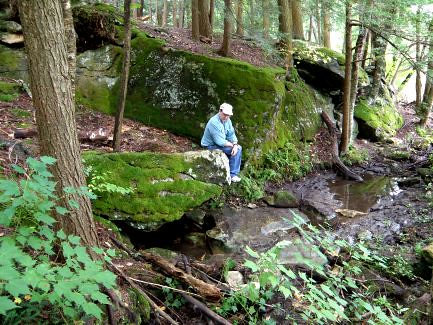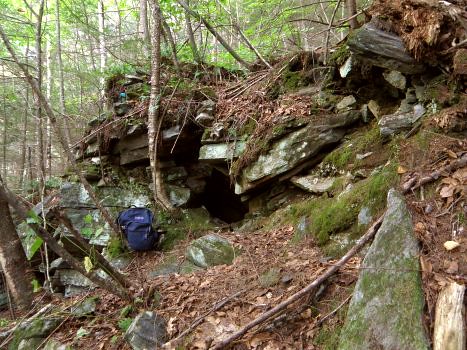
Devil's Pulpit and Cave
The goals on this trip were to find another access point, and to do a bit of good old reconnaissance. The site was once again the marvelous rock features within the Connecticut River Valley and was once known during the 1800's as a natural 'park'. Although I now have dozens of trips behind me when it comes to this area, its uniqueness cannot be understated. No where else in Massachusetts is so much incorporated into one area.
With that said, entrance to this section of the former 'park' was made by way of Mitchell Hill. This is one of many archaic names now long forgotten by both the modern generation and even the local residents. Making my way up the remains of a past mountain road, that once saw many a horse and carriage, I found suitable parking.
When the area was written about some 140 years earlier, the writer was very eloquent in painting the landscape with many a quaint term. One such description used was 'shelves' to describe the many ledges of rocks one encounters while ascending and roaming about the mountainside. Indeed these shelves diverge, converge, and disappear altogether.
My ascent was made steeply on a slope, stumbling upon the small pieces of arkose and conglomerate. On reaching my first plateau backed by a conglomerate 'shelf', it was time for the exploration to begin. Back and forth - weaving from one level to another - I finally stumbled into a 'devil's pulpit' formation with a cave! This shelf yielded many more interesting formations before merging into the main ledge once know as "The Home of the Rocks".
Right about at this point is the glorious Grand Porch, a sort of gigantic open faced shelter that is open on one side with its disintegrated remains forming small talus caves. By retreating along the direction I took, but upon a higher shelf, I took in a number of bear's dens and the area once called Titan's Pasture, a passing remembrance to the ancient Gods of past civilizations. It is not the only such recognition as we also have archaic references to Titan's Quarry, and the Titan's Dooryard.
But at Titan's Pasture is an interesting cave, hidden up in the ledges, with entrance gained only by climbing. This cave is another in a series formed in a manner described by speleologists as gravity slide or gravity assisted. Obviously the action of frost (hence: frost action) plays a part in 'quarrying' these large masses of rock from their parent ledge. But within this cave I was pleasantly surprised to see a bat. A healthy bat no less, free from the dreaded White Nose Syndrome (WNS) that has been ravaging their kind. Fecal matter indicates possibly more than one might use this as their hibernaculum.
Upon the exiting of Cave at Titan's Pasture, a methodical retreat was made down the mountainside checking shelf after shelf to more or less tie the exploration - past and present - all together.





